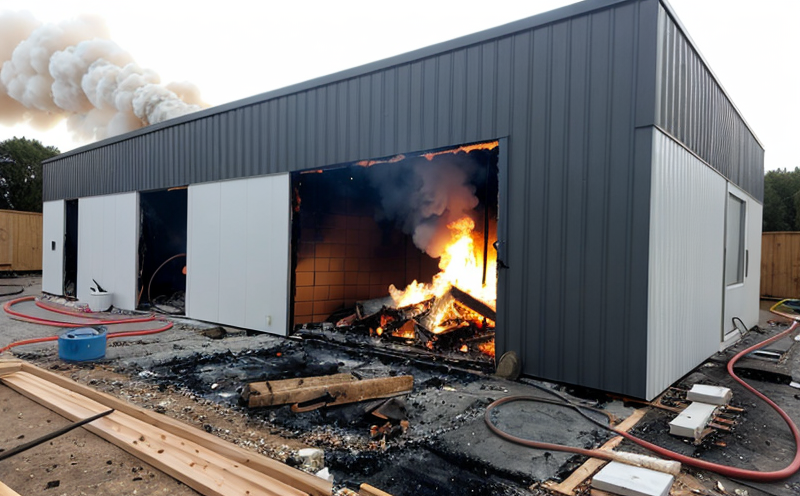Fire Resistance Testing of Lightweight Cladding Assemblies
The fire resistance testing of lightweight cladding assemblies is a critical process in ensuring that buildings are safe and compliant with international standards. This service involves the evaluation of the fire performance characteristics of cladding materials, which play a significant role in the overall building safety strategy.
Cladding systems are often installed on the exterior walls of buildings to enhance their appearance or provide additional insulation. However, these materials can also contribute significantly to the spread of fire if not designed and tested correctly. Therefore, it is essential to conduct rigorous testing to ensure that cladding assemblies meet stringent fire safety requirements.
The testing typically involves subjecting a sample of the cladding assembly to controlled conditions in a laboratory setting. The goal is to simulate real-world fire scenarios while ensuring that the test environment remains safe and controlled. This process allows for an accurate assessment of how well the cladding material performs under extreme heat, flame spread, smoke production, and structural integrity.
One of the key factors in fire resistance testing is understanding the composition of the cladding assembly. Lightweight claddings are typically made from materials such as metal, mineral wool, or expanded polystyrene (EPS). The choice of material can significantly impact the overall performance during a fire event. For instance, metal claddings generally provide better thermal insulation and resistance to heat transfer compared to lightweight EPS boards.
During testing, it is important to follow established standards such as ISO 15230-4 (for metallic building panels) or ASTM E1969 (for non-metallic systems). These international standards provide detailed guidance on specimen preparation, test setup, and evaluation criteria. Specimens are usually cut into standard sizes (e.g., 1m x 1m), ensuring consistency across different laboratories.
The testing process itself can vary depending on the specific requirements outlined in the relevant standards. Typically, a flame is applied to one face of the cladding assembly, and the other side is exposed to an airflow system. The duration of exposure depends on the type of fire test being conducted (e.g., vertical, horizontal, or wall section tests). Observers carefully monitor various parameters throughout the test, including temperature rise, smoke generation, and structural integrity.
After completing the testing phase, detailed reports are generated summarizing all observations and results. These reports serve as evidence of compliance with applicable regulations and provide valuable insights for ongoing improvements in design and manufacturing processes. Compliance officers and quality managers can use this information to ensure that their projects meet industry best practices and local building codes.
Understanding the importance of fire resistance testing is crucial for any organization involved in construction or renovation projects. By investing time and resources into thorough evaluations, stakeholders can significantly enhance safety measures and reduce potential risks associated with fire events within buildings.
Benefits
Conducting fire resistance testing of lightweight cladding assemblies offers numerous advantages that extend beyond mere compliance. It helps identify potential weaknesses early on, allowing for necessary adjustments before full-scale implementation. This proactive approach ensures higher levels of confidence in the final product's performance during actual emergencies.
The benefits also include enhanced reputation among clients and partners due to demonstrated commitment to safety standards. Additionally, successful completion of these tests can lead to reduced insurance premiums since insurers often favor structures that have undergone rigorous testing procedures. Furthermore, compliance with regulatory requirements reduces legal liabilities for non-compliance issues later down the line.
From an operational perspective, accurate fire resistance testing enables better resource allocation by pinpointing areas requiring improvement. It fosters a culture of continuous improvement within teams responsible for designing and installing cladding systems. Lastly, it contributes positively towards public trust through transparent communication regarding building safety measures implemented throughout construction phases.
Industry Applications
The application of fire resistance testing in the context of lightweight cladding assemblies is particularly relevant for various sectors including commercial buildings, residential complexes, and industrial facilities. These industries rely heavily on external cladding systems not only for aesthetic purposes but also to improve energy efficiency and reduce environmental impacts.
For instance, hotels and office blocks frequently use lightweight cladding materials due to their ability to withstand harsh weather conditions while maintaining attractive facades. By ensuring these materials pass stringent fire tests, developers can reassure clients about the safety of their investments. Similarly, hospitals and schools benefit greatly from reliable fire protection offered by compliant cladding systems which protect lives during critical times.
Industrial facilities like warehouses and manufacturing plants might opt for lighter weight options because they offer easier installation processes without compromising on strength or durability. In all cases though, the primary objective remains safeguarding occupants against fires through robust design and testing protocols.
Environmental and Sustainability Contributions
Incorporating fire resistance testing into the development of lightweight cladding assemblies aligns closely with broader sustainability goals. By selecting appropriate materials that pass rigorous tests, architects and builders contribute positively towards reducing carbon footprints associated with construction projects.
The use of recycled content in some lightweight claddings reduces demand for raw resources, thereby minimizing environmental impact. Moreover, improved fire resistance translates into longer-lasting structures which require less frequent replacements over time - further enhancing sustainability credentials. Additionally, compliant products may qualify for eco-labels or green certifications recognized globally, promoting responsible purchasing decisions among end users.
Through careful selection and testing of cladding materials, organizations demonstrate leadership in sustainable practices that benefit both present and future generations. This aligns with global initiatives aimed at combating climate change by encouraging more efficient use of resources throughout every stage of the building lifecycle.





